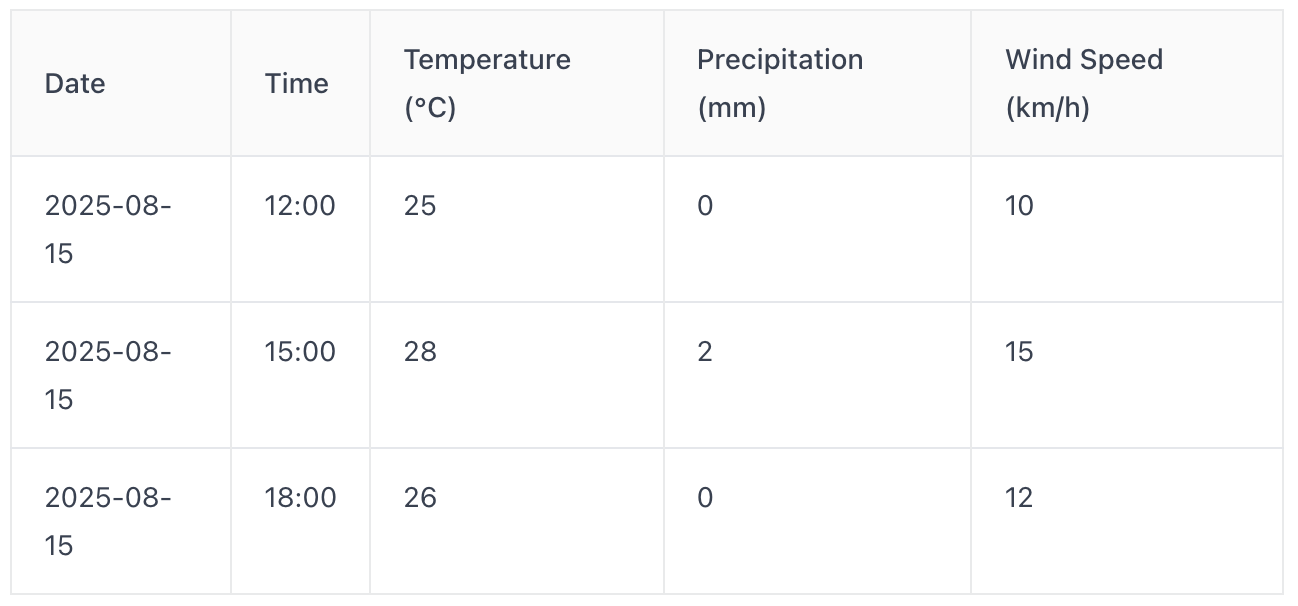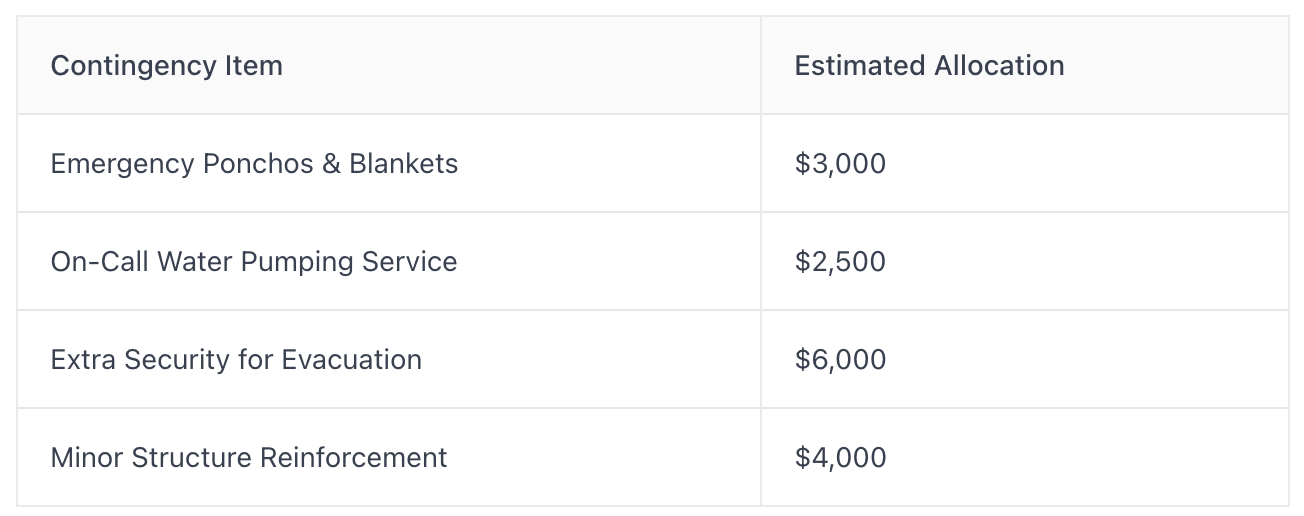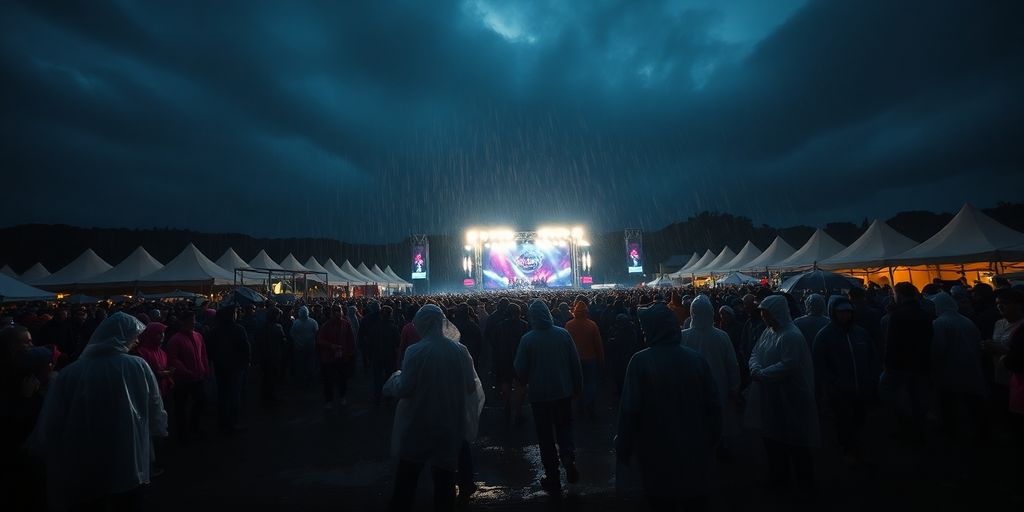Register as an organizer
Click the button below and finish your organizer registration, or fill out the form and we will be in touch to assist you.
.jpeg)
Planning big outdoor events, like music festivals in Europe, means you really have to think about the weather. It can change fast, and if you're not ready, things can get messy. This article is all about helping event organizers get their heads around what it takes to build a solid weather disruption contingency plan. We'll look at everything from understanding local weather patterns to making sure everyone stays safe and figuring out the money stuff.

Europe's weather is, well, all over the place. You can't just assume what works in Spain will work in Sweden. The continent has a bunch of different climatic zones, and each one brings its own set of challenges for outdoor events. Think about it: a music festival in the Mediterranean is going to have very different weather concerns than one in the Scottish Highlands. Knowing these zones is the first step in planning for weather disruptions.
Looking back can help you see the future, sort of. Digging into historical weather data gives you a sense of what's likely to happen during your festival. I mean, you can't predict the weather perfectly, but you can spot trends and patterns. For example, if your festival is always hit with a thunderstorm in the afternoon, you can plan for that. You can find this data from weather services, universities, and even some government agencies. It's not the most exciting reading, but it's super useful. You can use historical weather data to make informed decisions.
Don't try to be a weather expert yourself. Leave that to the pros. There are tons of meteorological services out there that can give you accurate, up-to-date forecasts. Some even specialize in event weather. These services can provide detailed information about temperature, precipitation, wind speed, and other factors that could affect your festival. Plus, they can give you warnings about severe weather, so you can take action before it's too late.
It's important to remember that weather forecasts are not always perfect. However, they can provide valuable information that can help you make informed decisions about your festival. Use multiple sources and stay updated as the event approaches.
Here's a simple table showing the kind of data you might get:

Festivals are all about good times, but Mother Nature doesn't always cooperate. That's why having a solid site infrastructure plan is super important. It's not just about setting up stages; it's about making sure everything can withstand unexpected weather. Let's break down how to do it right.
First things first, those stages and tents need to stay put. Wind is a major enemy, so proper anchoring is key. It's not enough to just hammer some stakes into the ground. You need to consider the wind load capacity of each structure and use appropriate ballasting or tie-downs. Think about it like this: you wouldn't build a house on a shaky foundation, right? Same goes for festival structures. Regular inspections before and during the event are also a must. Check for loose connections, damaged supports, and anything else that could become a hazard.
Rain, rain, go away... but if it doesn't, you better be ready. Poor drainage can turn a festival site into a swamp in no time. That means attendees are miserable, equipment gets damaged, and safety becomes a real concern. Effective drainage starts with site planning. Identify low-lying areas and create pathways for water to flow away from critical infrastructure. Consider using temporary drainage solutions like trenches, pumps, and absorbent materials. Also, think about the type of ground surface. Pavement is great for walkways, but it doesn't absorb water. Grass can get muddy quickly. A mix of surfaces is often the best approach. The URBREATH project is a great example of how to think about urban resilience.
Electricity and water don't mix, everyone knows that. But at a festival, you've got tons of electrical equipment running in an outdoor environment. That's a recipe for disaster if you're not careful. All electrical connections need to be weatherproofed and properly grounded. Use generators with automatic shut-off features in case of flooding or other emergencies. And make sure you have qualified electricians on-site to handle any issues that arise. It's also a good idea to have backup power sources in case the main system fails. No one wants the music to stop in the middle of the headliner's set because of a power outage.
Having a well-thought-out plan for power distribution is not just about keeping the lights on; it's about protecting people from harm. Regular inspections, proper grounding, and weatherproof connections are all essential components of a safe electrical system.
Having a solid evacuation plan is super important. It's not just about telling people to leave; it's about making sure they can do so safely and efficiently. You need to think about different scenarios, like a sudden storm or a fire.
We had a situation last year where a small fire broke out near the food vendors. Luckily, we had practiced our evacuation drill just a week before. People knew where to go, and our staff was able to keep things calm. It really showed the value of being prepared.
Communication can make or break a crisis situation. You need to be able to get information out quickly and accurately. This means having multiple channels available.
It's also important to have a designated spokesperson who can talk to the media and answer questions. This helps to control the narrative and prevent misinformation from spreading. Consistency is key here.
Working with local emergency services is a must. They have the resources and expertise to handle serious situations. You should establish a relationship with them well before the festival starts.
Having them on standby during the event can make a huge difference. They can provide medical assistance, help with crowd control, and respond to any other emergencies that may arise. It's all about being prepared and working together.

Okay, so picture this: you're at a festival, the music's pumping, and suddenly, the sky opens up. Or maybe it's the opposite – a cold snap hits out of nowhere. Having proper shelter isn't just a nice-to-have; it's a must. We're talking about more than just a few flimsy tents. Think robust structures that can actually withstand wind and rain. And if it's cold? Heaters, blankets, the whole nine yards. It's about keeping people safe and comfortable, so they can actually enjoy the event.
It's easy to underestimate how quickly weather can change, especially in certain parts of Europe. Being prepared with adequate shelter and warming facilities can make a huge difference in preventing weather-related incidents.
Heat can be just as dangerous as cold, especially when you've got thousands of people dancing and moving around. Dehydration is a real concern. You need to make sure there's plenty of water available, and not just at the bars. Free water stations are key. Also, think about shaded areas where people can cool down. And don't forget about educating attendees on the signs of heat stress. Prevention is always better than cure. When traveling internationally for festivals, ensure you have heavy-duty adapters for production equipment to safely handle high currents, especially for critical areas like stage power.
Alright, let's talk about the other extreme: cold. Hypothermia is no joke, and it can set in faster than you think, especially if people are wet or tired. The key is to have a plan in place for dealing with cold weather. This means having warming facilities available, like heated tents or buildings. It also means educating staff on how to recognize the signs of hypothermia and what to do about it. And, of course, encouraging attendees to dress appropriately.
Here's a quick rundown of what to look for:

Immediate medical assistance required
Let's talk about the money side of things. It's not the fun part of festival planning, but ignoring the financial risks of bad weather is a huge mistake. A sudden storm can do more than just dampen spirits; it can completely drain your event's finances if you aren't prepared. Having a solid financial plan is your safety net when the skies open up.
Getting insurance is a must, but not all policies are the same. You need to find coverage that specifically handles the kind of weather you're likely to face. An insurance policy for a festival in sunny Spain will look different from one for an event in rainy Ireland. You have to read the fine print to see what's actually covered. Some policies might pay out for a full cancellation but not for a delay or partial shutdown. It's your job to know the difference before you need it.
Key things to check in a policy:
Insurance is for the big disasters, but you also need cash on hand for smaller, immediate problems. This is where a contingency fund comes in. This is a separate part of your budget set aside just for weather-related expenses that pop up. Think about all the little things you might need in a hurry, like extra ponchos for attendees or hiring a crew to pump water out of a flooded field.
Having a dedicated contingency fund isn't just good planning. It's what gives you the freedom to act fast and make the right calls for safety, without having to scramble for money in the middle of a crisis.
Here’s a simple look at what that budget might include:

Your agreements with vendors are another area where you can protect yourself financially. A standard contract might lock you into paying a vendor in full, even if the festival is canceled due to a hurricane. You need to negotiate clauses that give you some flexibility. Talk to your suppliers, artists, and technical crews about what happens if weather disrupts the plan. Most are willing to work with you if you bring it up early. Getting these terms agreed upon in writing before you sign anything is probably the most important financial move you can make.
Look to include clauses covering:
Weather can throw a serious wrench into any festival, and how you talk about it before, during, and after can make or break the experience for everyone involved. It's not just about telling people what's happening; it's about building trust and showing you're on top of things.
Before the gates even open, get the word out. Let people know what to expect and how you're planning to handle potential weather issues. This is your chance to set the tone and show you're thinking ahead. Don't just say, "It might rain"; give practical advice. For example:
It's also a good idea to share links to local weather forecasts, so people can stay updated themselves. Make sure your crisis communication plan is ready to go.
When the weather actually hits, quick and clear communication is key. Use every channel you've got – social media, the festival website, announcements over the PA system, even text alerts if you have that set up.
Transparency is super important here. If there's a delay, explain why. If you're making changes, explain what they are and how they'll affect people. Don't try to sugarcoat things; just be honest and straightforward.
How the public and the media see your response to weather events can have a big impact on your festival's reputation. Have a plan for dealing with media inquiries and controlling the narrative.
Remember, even if the weather is terrible, you can still create a positive experience by showing you care and are doing everything you can to make the best of a bad situation. It's about turning a potential disaster into a demonstration of your commitment to your attendees.

Okay, so the festival's over, and hopefully, everyone's safe. But the work isn't done! Now comes the time to really dig into what happened during any weather-related incidents. We need to hold a proper debriefing session with all key staff members. This isn't about pointing fingers; it's about understanding what went right, what went wrong, and how we can do better next time. Get input from security, medical teams, stage crews, and even volunteers. The more perspectives, the better. Make sure to document everything – the timing of events, the decisions made, and the outcomes. This record will be super useful later on.
Once you've got all that juicy data from the debriefs, it's time to analyze it. Look for patterns. Were there communication breakdowns? Did certain procedures fail under pressure? Were there any near misses that we can learn from? Data analysis is key here. Maybe create a simple table to track the frequency of different issues:

Also, don't just focus on the negatives. Identify what worked well and figure out how to replicate those successes in the future. This is all about turning those weather-related headaches into learning opportunities.
Alright, so we've gathered the info, analyzed it, and now it's time to actually do something with it. This is where we update our contingency plans. Don't just file away the debrief notes and forget about them! Use the insights to make concrete changes to your procedures. Here are some things to consider:
The goal here is to create a living document that evolves with each event. Weather is unpredictable, and our plans need to be flexible enough to adapt. By continuously reviewing and updating our contingency plans, we can minimize the impact of future weather disruptions and keep everyone safe and happy.
Finally, make sure everyone on the team is trained on the updated plans. There's no point in having a great plan if nobody knows how to execute it!
So, there you have it. Getting ready for bad weather at European festivals isn't just a good idea; it's a must. Thinking ahead about what could go wrong, having a plan for when it does, and making sure everyone knows the drill can really make a difference. It's about keeping people safe and making sure the show can go on, even if the skies open up. A little planning now can save a lot of headaches later, and that means better times for everyone involved.
Looking at old weather records helps us guess what the weather might be like during your festival. It's like checking a calendar to see what usually happens each year.
We make sure all the big stuff, like stages and tents, is tied down really well so it doesn't blow away. We also have plans for water to drain away so things don't flood.
We have clear steps for everyone to follow if we need to leave quickly. We also use radios and phones to tell people what's happening and work closely with local police and fire departments.
We set up places where people can go to get out of the rain or cold. We also make sure there's plenty of water to drink if it's hot, and ways to warm up if it's chilly.
We buy special insurance that helps us if we have to cancel the festival because of weather. We also set aside money for unexpected costs and try to make deals with our suppliers that are fair if things change.
Before the festival, we tell everyone what to expect regarding weather. During the event, we send out updates right away. We also talk to news reporters to make sure everyone gets the right information.
More blogs
Click the button below and finish your organizer registration, or fill out the form and we will be in touch to assist you.